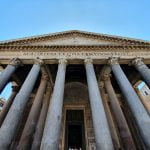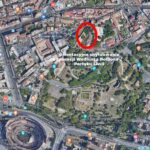The insula was built at the turn of the 1st and 2nd centuries CE and was later rebuilt many times. It is located at the foot of the Capitoline Hill, from Via del Teatro di Marcello, and is perfectly visible to everyone heading from Piazza Venezia towards the monumental stairs leading to Piazza dell Campidoglio. Today, only three floors of the tenement house protrude above the street level – the second and third floors, as well as a small part of the fourth floor. The ground floor and first floor are located in a deep excavation and can only be seen by leaning over the railing (be careful!). Unfortunately, only the second and third floors can be visited. The rest are closed and even with a reservation it is impossible to see them.
The insula at the foot of the Capitol is not a typical example of this type of building. You will find many reconstructions of similar buildings on the Internet, and they all somewhat resemble 19th-century tenement houses with a courtyard-well in the middle. Meanwhile, the insula discussed today was different. Because it was built on the slopes of the Capitol, there is no yard inside. In other words: it does not have four wings like the others, but only one. But its remaining features fit perfectly into the pattern of typical insula. A characteristic element from the outside was a two-story high portico. Interestingly, it was probably no different from the arcades that can still be found in many cities on the Mediterranean Sea. In Rome, its best-known equivalent is the semicircular arcades at Piazza Reppubblica, and its distant echo on the Vistula River are the arcades of Plac Konstytucji and Zbawiciela Square in Warsaw.
But let’s get back to our insula. The most characteristic feature is the vertical division of functions and “prestige”.
The premises on the lowest floor were intended for utility purposes – shops and taverns. By analogy with the insulae in Ostia or the buildings in Pompeii and Herculaneum, I assume that the first floor, shaded by a portico, was somehow connected with the business premises on the ground floor (this would also be indicated by the lack of brick ceilings between these two floors, which were replaced by wooden ones).
The second floor is interesting because the layout of the rooms suggests there are one or two quite comfortable apartments there. The rooms were quite spacious and high. The apartments opened onto a terrace above a portico shading the ground floor and first floor, so they were probably bright. It is possible that the walls were once decorated, but unfortunately there is no trace of the frescoes and other decorations. It is also impossible to determine the purpose of individual rooms. The Romans did not attach importance to defining the functions of rooms, as we usually do (living room, bedroom, kitchen, bathroom, etc.). The rooms met different needs depending on the situation, so today in insula they are not distinguished by any characteristic elements that we would expect from separate parts of the apartment.
However, I was most impressed by the rooms on the third floor, which are completely different from those on the floor below. It is not made up of spacious apartments, but of cramped rooms for rent. Their residents did not have access to the terrace used by the tenants of the second floor, so their communication was provided by a gloomy, dark corridor directly adjacent to the steep wall of the Capitol, running parallel to the building’s facade. But that’s not all. One might imagine that the people renting these rooms had at least some sunlight streaming in through the window facing the street. But a surprise awaits you here! The first floor was so divided into rooms that most of them had no access to any windows. They only had a door leading to a corridor with some light coming in from the street. And above the door – a tiny vent. It’s hard for me to imagine living in such conditions – in complete darkness, only by the light of a lamp, and in terrible stuffiness, because the said vent did not ensure actual air exchange (today it’s hard to imagine it, because the walls dividing these small rooms were demolished; they remained only traces of them).
Br… Terrible! Yet several people lived in one room. Probably when several mattresses were spread there, there was no way to move there. These are very different living conditions from those we have in mind when we imagine the life of a Roman patrician in his elegant domus.
My guide, Marta, explained to me that no traces of water or sanitary installations had been discovered throughout the entire insula.
As an interesting aside, I would like to add that on this floor there are fragments of the floor made of small bricks placed upright.
Finally, one comment: I was struck by the fact that, despite Vitruvius’s complaints about the poor quality of the materials from which the insulas were built, and Juvenal’s complaints about their impermanence, the insula at the Capitol made a very solid impression on me. The walls are very thick, and the individual floors are separated by strong brick vaults (I noticed that only the ceiling separating the ground floor from the first floor was once wooden). So maybe the complaints of the ancients were unjustified? Or maybe, on the contrary, I survived the insula dell’Ara Coeli because it was more solid than the others?
I saw Insula Ara Coeli thanks to cooperation with www.romasotterranea.it.
- Insula dell’Ara Coeli
- Insula dell’Ara Coeli








